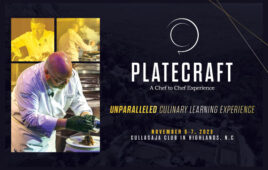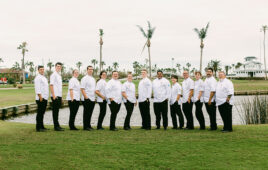Even in the heartland and one of the barbecue capitals of the world, Executive Chef Allen Blair finds ways to use a farm-fresh seasonal focus and special smoking techniques to shine a bright light on Shadow Glen GC’s culinary offerings.
Shadow Glen Golf Club in Olathe, Kan., outside of Kansas City, opened in 1989, with a course designed by golf legends Tom Weiskopf and Tom Watson (a Kansas City native). Golf Digest ranked Shadow Glen as the “Best New Club in America” in 1990 and soon after as the “Best Private Club in Kansas City.”
For the past 23 years, Allen Blair has been at the helm in the Shadow Glen kitchen. His farm-fresh focus and emphasis on seasonality is evident everywhere on Shadow Glen’s menu. And, even in one of the barbecue capitals of the world, he’s also found ways to raise the bar and provide special grilling treats for the club’s members.
In our conversation with Chef Blair, he was kind enough during his busiest time of the year to share some of his tips for preparing great barbecue, while also providing insights into other ways that he keeps advancing Shadow Glen’s exemplary culinary program.
C&RB: Allen, BBQ and smoking are obviously big in Kansas City. You had a smoker built for all of your specialties. Can you run through your program and tell us what are your most popular items, and why?
Blair: We smoke seasonally here at Shadow Glen, using locally aged hickory. I prefer to have good aged hickory, because the flavor profile is better than younger wood. Green wood can give off an odd flavor to the meats.
Baby-back ribs are the most popular item that we smoke here at the club. Pork butts are used for our pulled pork sandwich and pulled pork sliders. Probably my favorite food of all time out of the smoker is skin-on sides of fresh salmon.
My smoker was built in 2008 at a member’s sheet metal company. It is made of one hundred percent stainless-steel parts, so it will last for a very long time. The hinge on the door cost $150, just for that part. It’s amazing how expensive stainless is!
I had it designed so I could hang my ribs and have shelves that I could lay my briskets, pork butts, salmon and pork loins on. It has been a very well-used kitchen feature. The only problem is the weather here in Kansas—I can’t smoke if it’s too cold out. It just doesn’t work!
For outdoor club events, we put the smoker out close to the buffet line and just pull whole slabs of ribs out of it and carve them as people go through the line. It works really well, and the membership really enjoys seeing their food come out of it.
C&RB: You have almost 20 “small bites” plates on your menus, and I assume these are extremely popular. As this section grew, did it affect your average check?
Blair: The demographics of our club are changing and members enjoy trying new items—but entrée sizes can be too much for them. We developed our small-bites program to increase the number of items per table, and to help out with portion size.
You can reduce your costs with a smaller portion size, yet higher check averages. We were getting a lot of half-orders at the club, and those numbers have declined since the small-bites program started. It has been a great success!
C&RB: You have come very close to presenting your membership with a completely “gluten-free” menu. What have been some of the challenges you’ve faced in staying ahead of this curve?
Blair: Commercial gluten-free products are getting better, but most of them are still not very good. I try to develop my own recipes so I can adjust the flavor profiles for each of the menu items.
Not every gluten-free flour is the same, and the type of flour that is put in the mix will affect the flavor outcome. My kitchen is a small one and we only have two fryers, so some items we can only do as a modified gluten-free item.
Training the staff to the dangers of cross-contamination is integral to the success of our program. We have allergens placed on the tickets that come back to the kitchen, so all staff members know what they are dealing with.
C&RB: Chef, you are the keeper of the point-of-sale system at your club. What are the main maintenance issues you try to stay on top of on a seasonal or daily basis?
Blair: As most chefs know, there are never enough modifiers or prep options on any POS system. When you think you have covered all of your bases, someone finds a loophole you never saw coming.
In our operation, the kitchen department is in charge of all food-related POS placement. I have trained my sous chefs to set up the daily menus so we stay on top of the process.
My menus change seasonally, so I have to add items as we go through those changes. Our specials are also added on a daily basis, with all the prep options attached. This allows us to know what we need to price for those items. I also have to change menu panels at least every other year, so that the menus can hold all of our items.
This season, we are trying to limit our menu items to help with speed of service. As our demographics change, we are finding that our club usage is up in the F&B operation. It can be challenging for the seasonal wait staff to learn the menu panels, so streamlining those menus is key.
C&RB: Allen, how do you stay fresh and reinvent yourself every year after 23 years at Shadow Glen?
Blair: Reading industry publications is important to keep fresh and know about what’s happening in the marketplace. I also try to travel as much as my schedule permits, studying menus as I visit different parts of the country. I really like to have regional offerings on my menus. Attending the Chef to Chef Conferences also really helps me stay in tune with what is happening in the industry! (I have been to all but the very first Chef to Chef.)
C&RB: Having attended multiple Chef to Chef Conferences, what are some of the big takeaways you’ve been able to bring back to apply at your club?
Blair: I have left each Conference feeling that I accomplished a lot. My use of sous vide techniques has really been drawn from things that I have seen or talked about with fellow chefs at the Conferences.
One of the biggest positives is just the exposure to the talent assembled at each Conference. There is a lot of knowledge floating out there, from the presenters to purveyors to other chefs.
The camaraderie at the Conferences is a very important element to me. Meeting chefs from all over the country and the friendships that I have developed are great. I look forward to returning every year.







